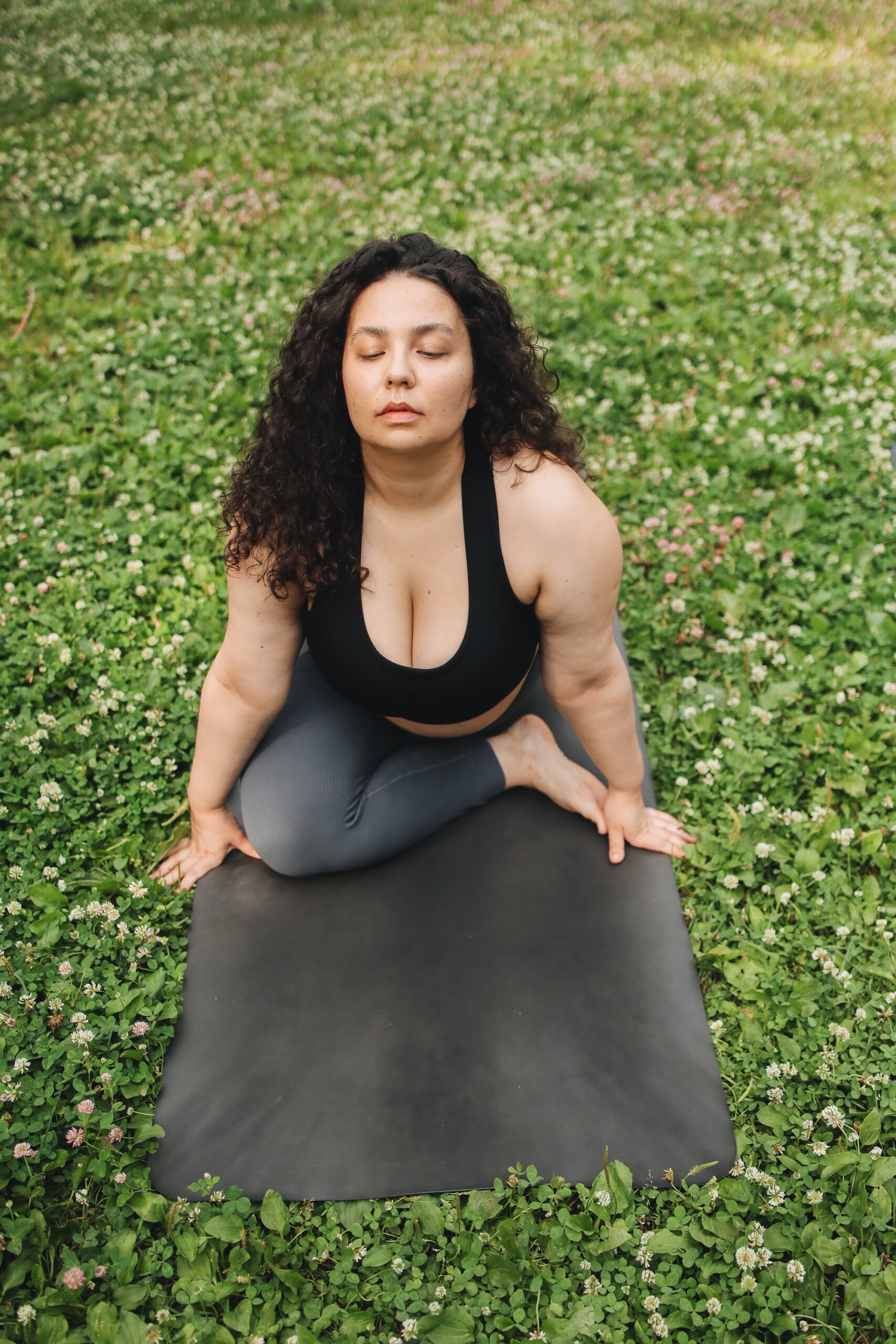Home > Female Body > Menstrual cycle > Top benefits of cycle syncing workouts for every phase

 Written by
Stacy Miller
Written by
Stacy Miller

Whether you’re new to your exercise journey or have been at it for years, you may have noticed that your workouts are harder during certain times of the month. It’s not in your head; there’s a biological reason. Throughout your menstrual cycle, your body experiences numerous hormonal fluctuations, which impact it in different ways. During one phase, you may feel strong and have no trouble conquering the toughest exercises, but in another, you are easily winded and can even feel weak. These variations are why many women choose cycle syncing workouts. Cycle sync workouts are designed to align with each phase of your menstrual cycle, helping you optimize your energy levels, reduce menstruation symptoms, and even improve your mood. But what is cycle syncing, and what are the benefits of working out according to your cycle? Keep reading to find out.
Did you know that evidence shows a link between the impact of exercise and menstrual cycle phases in women? It’s true. Women are at a higher risk of foot and ankle injury during workouts than men, and our hormonal fluctuations may be to blame. As your hormones rise and fall, they affect numerous functions like neuromuscular control, strength, and laxity. That means women are constantly having to adapt to changes in their bodies, which puts us at a higher risk of workout-related injuries.
That’s why cycle syncing exercise is so appealing. While it may seem complicated, workout cycle syncing is simply following an exercise routine that best fits each phase of your menstrual cycle. You prioritize listening to your body and aligning your workouts with your cycle to improve results and reduce your risk of injury.
The concept of adjusting your exercise based on menstrual cycle phases isn’t new, but it’s not yet widely accepted among scientists. It comes from the belief that changes in sex hormones, namely progesterone and estrogen levels, impact athletic performance. The hypothesis makes sense since we know that shifts in hormone levels can cause numerous symptoms like mood swings, PMS, sleep issues, weight gain, and more. To better understand why exercise cycle syncing is effective, we need to quickly discuss how the menstrual cycle works.
There are two phases of the menstrual cycle: follicular and luteal. Each phase is divided into different stages – early follicular or menstruation, mid-follicular, late follicular or ovulation, early luteal, and late luteal. In studies, women in the early follicular phase showed reduced exercise performance, while those in the late follicular phase during ovulation experienced peak strength. Energy levels tend to be lower during the late luteal and early follicular stage, when you’re on or starting your period.
Following these findings, you’d create a cycle syncing workout plan that prioritizes strength training during the late follicular or ovulation stage and less intensive exercises like yoga or pilates during the early follicular phase. Of course, all women are different, and your body may react to hormone fluctuations differently, so you’ll have to develop a workout plan that best aligns with how you feel.
Now that you have a better understanding of the benefits of choosing specific workouts for menstrual phase variations, let’s discuss which exercises work best during each phase.
As you remember, your follicular phase starts with a period. Period workouts can be more difficult due to lower estrogen levels and symptoms like cramping. If you’re struggling to maintain the same intensity, it’s best to stick to low-impact, less-intense workouts during your period, and we’ll cover them later.
Apart from the early follicular phase when you have your period, the follicular phase is when you generally feel your best. Since you tend to have higher energy thanks to higher estrogen levels, it’s a great time to focus on strength training. Here are some ideal exercises to add to your cycle syncing exercise chart during the follicular phase of your menstrual cycle.
Higher energy levels make this phase a great time to focus on muscle growth and development. Try incorporating weights with compound movements like bench presses, overhead presses, deadlifts, lunges, and squats. Now is when you can push yourself harder with your strength training and put on more muscle mass.
During the follicular phase, you can work on building your endurance through cardiovascular exercises. Running, cycling, swimming, hiking, and similar exercises are great for your overall health and help you reach your fitness goals. Adding cardio to your cycle syncing workout chart is an excellent way to keep your body moving.
When choosing workouts based on menstrual cycle phase, high-intensity interval training or HIIT, is definitely one you’ll want to add. HIIT training workouts alternate between short periods of intense exercise and rest to maximize calorie burn. They often include burpees, mountain climbers, sprints, and jumping jacks.
During the first half of your luteal phase, you may feel no different from your follicular phase and follow the same training routine. However, for some, mood changes start right after ovulation and may result in less energy for being active. If that’s the case for you, you can follow the workouts designed for the second half of the luteal phase.
During the late luteal phase, you may notice that your energy levels are lower, and it’s harder to perform many of the same exercises that you did with ease during the follicular phase due to PMS and upcoming period.
Just because you’re in your luteal phase doesn’t mean you can’t still enjoy cardio workouts. Instead of high-intensity exercises like running, switch to gentler options like swimming or walking. You’ll keep your body moving while still caring for your heart.
Strength training is also possible during the luteal phase, but instead of focusing on high weights and lower reps, opt for low weights and higher reps. You can also choose bodyweight exercises like pushups or incorporate resistance bands instead of traditional weights.
Yoga is great for the entire luteal phase. If you’re wondering what workouts to do on your period, yoga is an excellent option. This gentle workout lets you move your body and stretch sore muscles. It focuses on core strength, which is beneficial for stability, balance, and preventing injuries.
Pilates is our favorite workout for the luteal phase, but also it is great for your period. Focusing on gentle workouts on your period, like pilates, can help you maintain your fitness goals. Similar to yoga, pilates offers a low-impact way to strengthen muscles and build your core. It improves posture, flexibility, mobility, muscle endurance and strength.
While many women find a great success cycle syncing their workouts, there may be challenges that can impact its effectiveness. Let’s explore some of the top difficulties you may encounter and discuss how to overcome them.
Cycle syncing workouts rely on a fairly predictable 21-38-day menstrual cycle. If your cycle is shorter or longer, it could be difficult to schedule your workouts effectively. Using a hormone app tracker like Hormona can help you track your cycle so you know which phase you’re in and can adjust your workouts accordingly.
Hormonal birth control suppresses ovulation in most cases, which means that your hormones won’t follow the same pattern as they do in the natural cycle; instead, they will remain stable. Some women find that cycle syncing isn’t as effective with this type of contraceptive.
Stress can impact your body in many different ways, including hormone deregulation. If you’re experiencing high stress levels, it could cause irregularities in your cycle, which makes cycle syncing harder. Implementing mindfulness techniques like meditation, journaling, and spending time in nature can help reduce stress levels and make cycle syncing more effective.
Cycle syncing can feel overwhelming at first, which is why we’ve made this list of tips you can use when getting started to help you succeed.
The most important part of cycle syncing is tracking your cycle. You need to know which phase of your menstrual cycle you’re in so you can perform the correct exercises. Using a tracker like Hormona makes this process easy by taking out the guesswork.
As we discussed, there’s two phases of the menstrual cycle: follicular and luteal. Being able to identify them is an easy way to ensure your workouts stay on track. The follicular phase starts with your period and ends with ovulation. During this phase, your basal body temperature should remain steady but will begin to rise between 0.4° and 1.0°F (0.2° and 0.6°C) right after ovulation.
You may also look for changes in your cervical mucus, which will become a clear, stretchy egg white consistency. During the luteal phase, between ovulation and your period, your basal body temperature will remain slightly elevated, and your cervical mucus becomes paste-like and thick.
You can get even more benefits out of a cycle sync workout plan by incorporating phase-specific cycle syncing diet . For example, during the follicular phase, you can focus on iron-rich foods like red meat, spinach, and beans. Complex carbs like brown rice and quinoa, lean meats, and healthy fats will also give you the nutrition you need. During the luteal phase, you can keep cravings at bay with fiber-rich foods like veggies and fruit and high-protein options like dairy and lean meats. Be sure to always drink plenty of water and limit processed and sugary foods.
Cycle syncing workouts can take some getting used to, which is why it’s important to be mindful of your cycle phases when starting out. Use a tracker, keep a journal, and be patient with yourself as you get used to the process.
Cycle syncing is growing in popularity, but that doesn’t mean it’s widely accepted within the scientific community. While not all experts agree on its effectiveness, there’s no denying that the menstrual cycle has a huge impact on a woman’s body. If you experience symptoms like extreme fatigue, sleep problems, nausea, etc., that interfere with your daily life, you should seek medical advice from a healthcare professional.
Hormona is the award-winning hormone-tracking app that’s revolutionizing women’s hormonal health. It provides the insights and tools you need to understand your body better so you can feel your best.
FAQ
While there’s no specific rule saying you shouldn’t lift heavy things on your period, for some women, it can be more difficult. Heavy lifting causes you to put excess pressure on your pelvic floor, which may cause discomfort. It may also lead to increased fatigue.
While cycle syncing itself won’t make you lose more weight, maintaining a consistent workout routine paired with a healthy diet can make it easier to reach your fitness goals. Developing healthy habits like working out, eating nutritious foods, drinking plenty of water, and limiting processed food will help your body feel its best and make maintaining a healthy weight easier.
Incorporating healthy, nutrient-dense foods into your diet will give you the fuel you need to get the most out of your cycle syncing workout. Aligning your meals with your cycle phases will also help support hormone balance and give you plenty of phase-specific nutrients when you need them most.
Working out throughout your cycle is the best way to keep your body feeling great all month long. During the late follicular and ovulation stages, you’ll have the most energy, which can make your workouts feel easier and let you go harder.
If you’re feeling okay, there’s no time that you shouldn’t work out on your period. It’s a good idea to stick to low-intensity exercises if your energy is low or you have symptoms like cramping. Walking, swimming, yoga, and pilates are excellent workouts to try during your period.


-


Dr Singh is the Medical Director of the Indiana Sleep Center. His research and clinical practice focuses on the myriad of sleep.

What is estrogen and why is it important? Estrogen is one of the main sex hormones responsible for menstrual cycle regulation. It prepares your uterus for pregnancy and affects breast tissue development. But it isn’t just your reproductive system that

Perimenopause and fertility: What you need to know After mid 40, many women start the transition to menopause, this stage is called perimenopause. This is the time when your hormones start to behave differently and fertility decreases. Whether you already

The role of hormones in perimenopause Throughout your menstrual cycle, you experience normal hormonal fluctuations that are responsible for proper bodily functions like ovulation and menstruation. However, once you enter perimenopause, your hormone fluctuations change. As ovaries become less responsive
Privacy Overview
| Cookie | Duration | Description |
|---|---|---|
| cookielawinfo-checkbox-analytics | 11 months | This cookie is set by GDPR Cookie Consent plugin. The cookie is used to store the user consent for the cookies in the category "Analytics". |
| cookielawinfo-checkbox-functional | 11 months | The cookie is set by GDPR cookie consent to record the user consent for the cookies in the category "Functional". |
| cookielawinfo-checkbox-necessary | 11 months | This cookie is set by GDPR Cookie Consent plugin. The cookies is used to store the user consent for the cookies in the category "Necessary". |
| cookielawinfo-checkbox-others | 11 months | This cookie is set by GDPR Cookie Consent plugin. The cookie is used to store the user consent for the cookies in the category "Other. |
| cookielawinfo-checkbox-performance | 11 months | This cookie is set by GDPR Cookie Consent plugin. The cookie is used to store the user consent for the cookies in the category "Performance". |
| viewed_cookie_policy | 11 months | The cookie is set by the GDPR Cookie Consent plugin and is used to store whether or not user has consented to the use of cookies. It does not store any personal data. |
